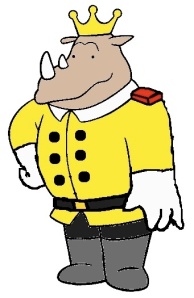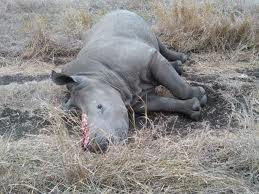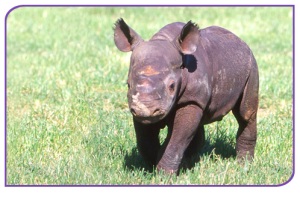Today, June 5, is the start of International Year of the Rhino 2012. The rhinoceros is not only a creature of Africa – in fact, it was President Susilo Bambang Yudhoyono of Indonesia who made today’s announcement. In his own country, the mainland population of the Sumatran Rhinoceros (Dicerorhinus sumatrensis lasiotus) is listed as Critically Endangered on the International Union for the Conservation of Nature‘s (IUCN) Red List of Endangered Species. It is one of the most endangered mammals on Earth. The Black Rhinoceros (diceros bicornis) and the Javan Rhinoceros (rhinoceros sondaicus) are in the same category.
Last November, I wrote a blog post about the Western Black Rhinoceros (the “animal with the golden horn”) – which the IUCN has now declared extinct; its last known habitat was Northern Cameroon. It is hunted for its horn, which the Chinese and Vietnamese value highly for its alleged aphrodisiac qualities. Africa’s Northern and Southern White Rhinoceros (Ceratotherium simum) is now Near Threatened, according to the IUCN, but its population has increased somewhat, despite its extinction in countries such as Sudan, Southern Sudan, Chad and the Central African Republic. It has been introduced in Zambia, and reintroduced in five other countries. For the record, the Indian Rhinoceros (rhinoceros unicorns) is Vulnerable.

The African Wildlife Foundation and other organizations are seeking funding to support the conservation of the Black Rhinoceros, whose survival is on the brink. If you can donate $10, $20 or $30 towards the survival of one of these magnificent animals, please do so. Meanwhile, scientists such as those at the San Diego Zoo and elsewhere are doing incredible work to see if they can get the rhinoceros to reproduce more quickly and to reintroduce them into the wild. Conservationists seek to monitor their ranges and their numbers (at one time the population of White Rhinos was down to 2,500) and to raise awareness of rhino conservation issues.
I have always been a fan of Babar the Elephant since my youth (and before the cartoon movies, which admittedly aren’t bad). Lord Rataxes of Rhinoland, which adjoins Babar’s Celesteville, is a lovable and important character. His somewhat smarter Lady Retaxes is the power behind the throne. Lord Rataxes is a somewhat uncertain ally of Babar, perhaps less refined, and often does the wrong thing. Wouldn’t it be sad if this wonderful character became a symbol of the days when the rhinoceros roamed wild and free across the plains of Africa?
Please look at the links below, and see if there is any way in which you can assist in the conservation of these monumental creatures.


Related links and websites:
http://www.rhinos-irf.org/afrsg/: International Rhino Foundation (African Rhino Specialist Group)
https://petchary.wordpress.com/2011/11/18/black-african-extinct/: Black, African…Extinct – the Western Black Rhinoceros
http://www.awf.org/content/wildlife/detail/rhinoceros: African Wildlife Foundation
Rhinoceros Undergoes Assisted Reproduction to Rescue Species from Extinction (scientificamerican.com)
Photo of the Day Contest, “Red Rhino”, An exquisite photograph of a (bushwarriors.org)
Video – Watch White Rhinos being saved from poachers’ wounds! (conservationguardians.com)
The Trivial Eye: Extinct Animals (woot.com)
Poachers kill last female rhino in South Africa’s Kruger park for prized horn (guardian.co.uk)
Rhinos May be Extinct in South Africa by 2015 (treehugger.com)

Nice,
Thanks for your greatful informations, working in, ASIAN AFFAIRS MAGAZINE.
Try to post best informations like this always
Endangered species: Rhino: If they’re gone, they’re gone forever
LikeLike
Thank you so much for this link. It is absolutely tragic. Can you imagine them gone forever?
LikeLike
Hi Petchary, This is what I’ve been adding to my friends blogs my explain my absence: I apologize for being AWOL for so long…. It now makes sense to me how important it is to grow gradually. I was receiving 3000-5000 emails and it was a nightmare to respond to all in a timely fashion; even with a system in place. Finally, I had to shut off notifications and clear the deck and get back to a more manageable number… I learned a lot from the experience too — about human nature. Be blessed and thanks for your patience. 🙂
LikeLike
Good heavens! No wonder you had to take a break. That is totally unmanageable, but shows what a wonderful following you have for your blog! Congratulations! And meanwhile, please don’t worry. Take your time!
LikeLike
As a matter of fact, many of them have abandoned ship… some following. 😆 So who knows eh? In today, out tomorrow… such is life. It’s all good. TY for your support. 🙂
LikeLike
Oh… That’s not good… but maybe they weren’t serious followers in the first place. Don’t worry about it. By the way, do you live in the UK (if you don’t mind my asking?)
LikeLike
I live in NY but moved here from the UK. Why do you ask?
LikeLike
I’m liking the new design
LikeLike
Thanks. I was really sick of the other one… Thought this one was a little bit retro-ish and simple… Will probably tinker with it some more…
LikeLike